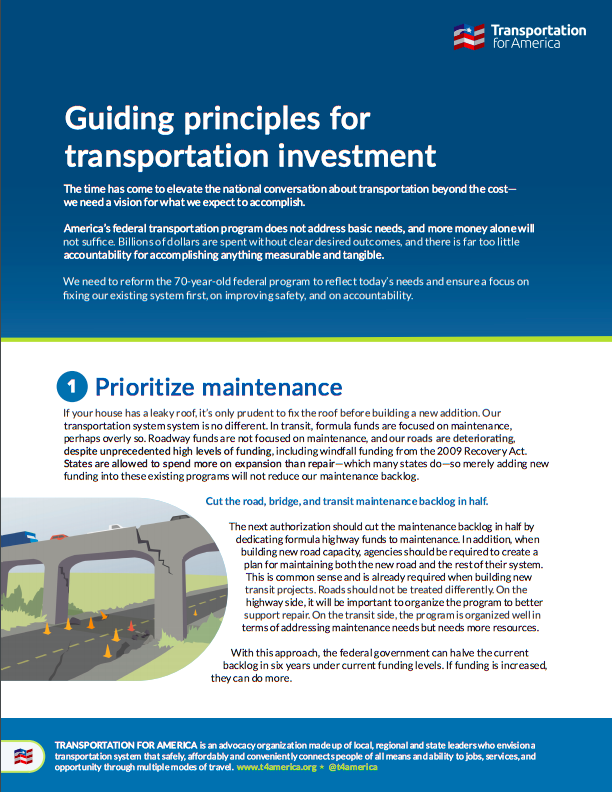Posts Tagged "biking"
Many of the most dangerous states for people walking are planning for more people to die
13 Americans per day were struck and killed while walking by drivers from 2008-2017, according to a report released today by our colleagues at the National Complete Streets Coalition. Dangerous by Design 2019 also shows how some of the most dangerous states are, astonishingly, committed to making the problem even worse.
Changing the transportation paradigm, one project selection at a time.
Thanks to support from the Kresge Foundation, Transportation for America helped several regions around the country take tangible steps toward aligning their spending with their policy goals using performance measures. We asked them about it…here’s what they said.
On National Walking Day, too many Americans are still having to endure unsafe streets
While we missed recognizing National Walking Day last week while the Complete Streets conference was happening in Nashville, we wanted to come back this week and revisit a post from 2012 looking at what’s actually keeping more people from walking in many of our metro areas.
Coming soon: A new report on how metro areas are building more and better bicycling and walking projects
Metro areas of all sizes across the country are strategizing, developing, and implementing new ways to improve bicycling and walking in their regions. Over the last year, T4America worked with metro areas across the country to collect and document these stories, ideas, and strategies into a guidebook that we’re releasing on December 11.
Federal program that helps tackle health disparities threatened in ’18 budget
Congress is threatening to eliminate a small yet significant federal program housed within the Centers for Disease Control and Prevention (CDC) that helps local communities take concrete steps to prevent someone’s zip code from being the most powerful determinant in their long-term health.
How are metro areas prioritizing health and building more biking and walking projects?
Though there’s booming demand all across the country to build more projects that can help residents get out and bike or walk — whether for exercise or just for getting around safely from A to B — it can be an uphill battle to do so. How are metro areas upending the conventional wisdom and building more projects that help improve their residents’ health?
Introducing “Dangerous by Design 2016”
Between 2005 and 2014, a total of 46,149 people were struck and killed by cars while walking. That averages out to about 13 people per day.
Webinar wrap: How MPOs are prioritizing public health to build prosperous regions
Last week, we had a discussion detailing how public health professionals are working with regional transportation planners to plan, fund, and support building more state of the art active transportation projects — accompanying the release of Measuring What We Value: Prioritizing Public Health to Build Prosperous Regions.
Urban bike trails in cities like Indianapolis, Dallas and Atlanta are proving to have rich economic benefits to city neighborhoods
Affirming a trend seen in other cities, Indianapolis’s eight-mile Cultural Trail has been a boon to the neighborhoods adjacent to it — as well as the city as a whole — increasing property values of homes and businesses and giving residents and tourists an efficient, unbroken path to walk, bike and move around the city.
Healthy economies need healthy people — Nashville leads the way for other regions
What’s the connection between healthy residents and a healthy bottom line? Why should a local business community care about improving the health of the residents that live there? Representatives from five regions gathered last week in Nashville to learn how providing better transportation infrastructure and building more walkable communities can help improve residents’ health — and boost local economic prosperity and competitiveness.





